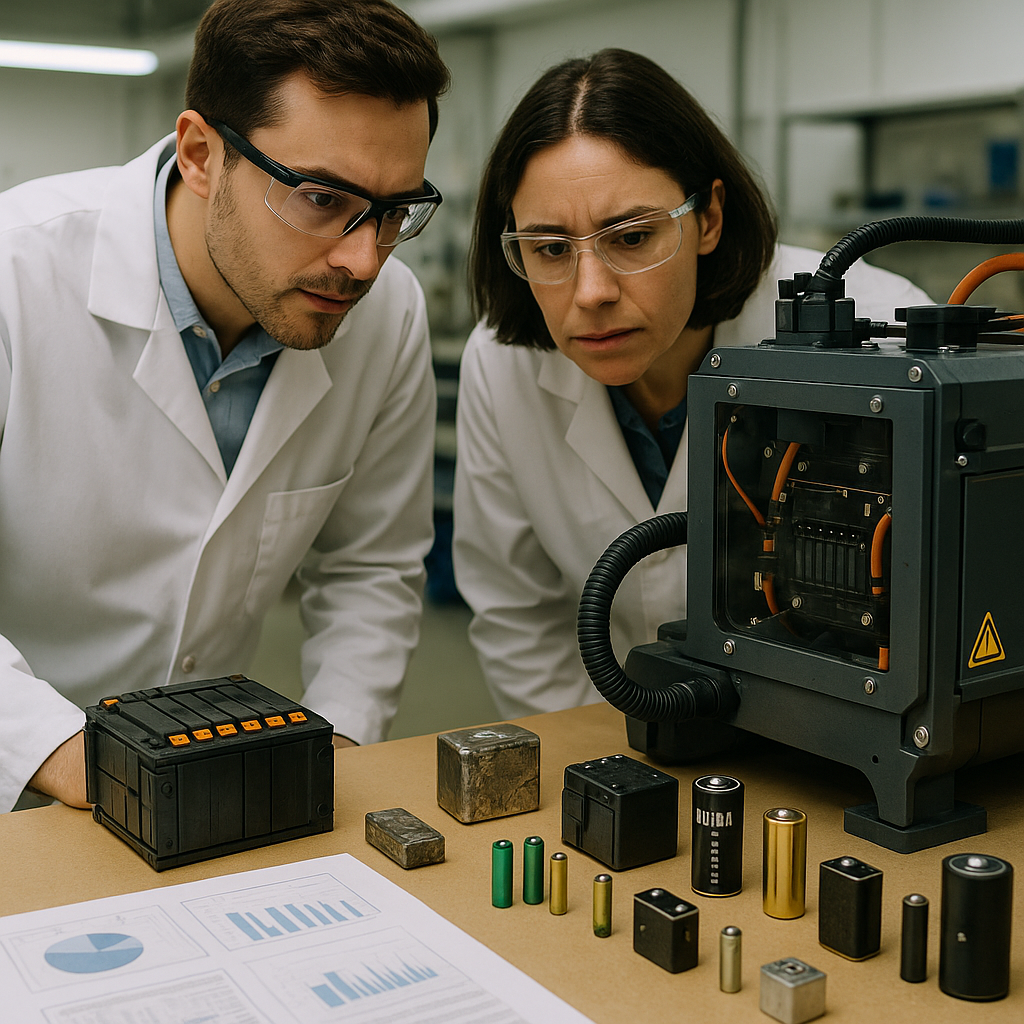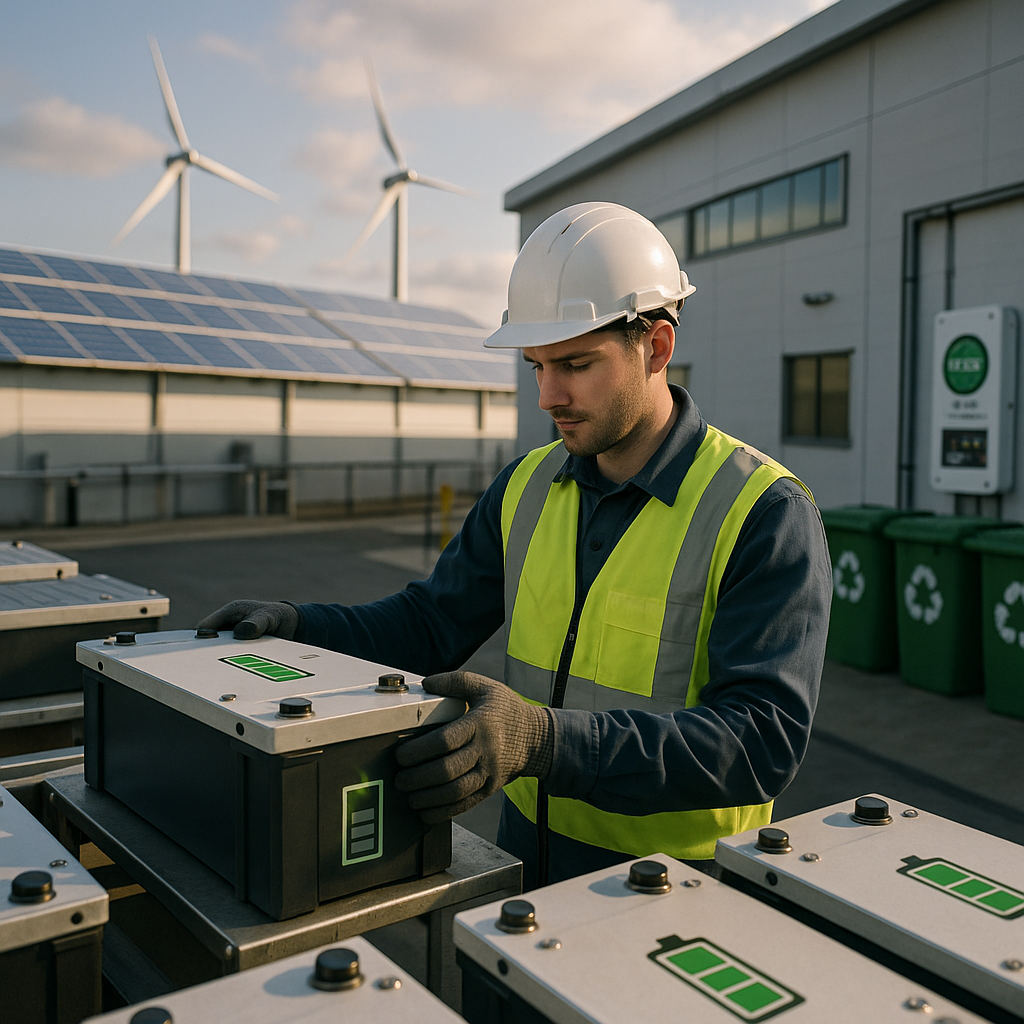5901 Botham Jean Blvd, Dallas, TX 75215
What is Lithium Battery Recycling? Explained Simply
August 28, 2025From smartphones to electric vehicles, lithium-ion batteries power our modern world. As these devices reach the end of their useful life, a growing challenge emerges. The battery inside your phone contains the same valuable elements found in electric cars. These materials are too precious to waste.
Lithium battery recycling involves safely collecting and processing used lithium-ion batteries to recover valuable materials and prevent environmental hazards. It entails gathering spent batteries from various sources, including consumer electronics and electric vehicles. These batteries contain critical minerals like lithium, cobalt, nickel, and manganese that can be reclaimed.
The recycling process typically begins with collection and sorting. Batteries are then discharged to prevent fires during processing. Next, mechanical processing shreds the batteries to separate their components. Specialized techniques extract valuable metals for reuse in manufacturing new batteries, supporting a circular economy for these increasingly important resources.
Why is Lithium Battery Recycling Important?

Lithium battery recycling is a cornerstone of sustainable resource management in our electrified world. It recovers valuable materials like lithium, cobalt, nickel, copper, and manganese from spent batteries, addressing several critical challenges simultaneously.
Conserving Critical Minerals
The minerals used in lithium-ion batteries are finite and valuable. Recycling helps conserve these resources, reducing the need for continuous extraction from the earth. Studies indicate that recycling can save up to 51% of natural resources compared to mining new materials, including reducing fossil fuel consumption in extraction processes.
With forecasts suggesting potential shortages of cobalt, nickel, and lithium within the next decade, recycling is a practical solution. Recovered materials from lithium batteries can be economically beneficial, with components often having up to 10 times higher value than other recyclable materials.
Supporting the Clean Energy Transition
As demand for electric vehicles and renewable energy storage grows, so does the need for battery materials. Recycling creates a domestic supply chain for these critical minerals, reducing reliance on international sources and enhancing energy security. Currently, the transport distance for conventional mining and refining of battery metals averages about 35,000 miles—close to circling the Earth one and a half times.
A Stanford University lifecycle analysis published in Nature Communications found that battery recycling emits less than half the greenhouse gases of conventional mining and uses about a quarter of the water and energy. For manufacturing scrap streams, which comprise about 90% of recycled supply, the benefits are even more significant.
Preventing Environmental Hazards
Improper disposal of lithium batteries can cause serious environmental contamination as they contain potentially hazardous materials. These materials can leach into soil and water, threatening wildlife and human health. Recycling prevents these pollutants from entering ecosystems and helps mitigate broader environmental impacts of battery waste.
Advanced recycling methods can recover nearly all materials—up to 99% in some processes—minimizing waste streams and environmental degradation. Techniques like direct recycling preserve the engineered cathode structure, saving energy and reducing manufacturing needs for new batteries.
Reducing Fire and Safety Risks
Lithium batteries pose significant fire hazards when improperly disposed of in landfills or regular recycling systems. They can ignite if damaged or mishandled, endangering workers and nearby communities. The U.S. Environmental Protection Agency has determined that most lithium-ion batteries are likely hazardous waste when disposed of because they might catch fire or explode if not handled carefully.
Proper recycling channels safely manage batteries through specialized facilities equipped to handle their unique risks. This approach significantly reduces the likelihood of dangerous incidents while recovering valuable materials.
Creating Economic Opportunities
The lithium battery recycling industry is a growing economic sector with substantial job creation potential. As battery use expands, recycling facilities are scaling up to meet demand, providing new employment opportunities in collection, processing, and materials recovery.
In Europe, battery recycling is considered an urban mine, reducing reliance on imports and supporting the circular economy. Many experts anticipate the launch of more gigafactories focused on battery recycling within the next 5-10 years, amplifying economic benefits.
While the U.S. currently recycles about 50% of available lithium-ion batteries, it has successfully recycled 99% of lead-acid batteries for decades—demonstrating the potential for improving lithium battery recycling rates with proper systems.
As the clean energy transition accelerates, developing efficient recycling infrastructure is essential for managing the millions of tons of battery waste projected in coming years while recovering the critical materials needed to sustain our renewable energy future.
How Does the Lithium Battery Recycling Process Work?

The lithium battery recycling process consists of several key stages designed to efficiently recover valuable materials. Each step is crucial for transforming end-of-life batteries into reusable resources for new battery production.
Collection and Sorting
The process starts with the collection of batteries from various sources, including consumer electronics, electric vehicles, and energy storage systems. These batteries are gathered through dedicated collection points, retailer take-back programs, and specialized e-waste facilities.
Once collected, batteries are sorted according to their chemistry types to ensure appropriate handling. Different lithium-ion chemistries, like lithium cobalt oxide, lithium iron phosphate, and lithium nickel manganese cobalt, require specific recycling methods. Sorting can be done manually or with automated systems that identify battery types.
Discharge and Dismantling
Before processing, batteries must be safely discharged to eliminate electrical hazards. This is accomplished using controlled resistors or specialized discharge equipment. For larger batteries, such as those from electric vehicles, technicians dismantle them into smaller components, separating modules and removing external casings.
This careful disassembly allows for the recovery of intact components like copper wiring, circuit boards, and plastic casings, which can be recycled separately. Some facilities also assess batteries at this stage for potential second-life applications before full recycling.
Shredding and Material Separation
The core recycling process typically involves mechanical shredding to break down batteries under controlled conditions, preventing fires. This creates a powder-like mixture called “black mass,” which contains valuable metals from the cathodes and anodes.
Various separation techniques are then used to isolate different materials:
- Magnetic separation removes steel components.
- Air classification separates light plastics from heavier materials.
- Sieving sorts materials by particle size.
- Density separation further refines the material streams.
Metal Recovery Methods
Two primary methods extract valuable metals from the black mass:
Pyrometallurgy (Smelting)
This heat-based process uses high temperatures (over 1000°C) to melt battery materials. Metals form alloys during smelting, which can be further refined. While effective for recovering cobalt and nickel, pyrometallurgy often struggles with lithium recovery, which typically ends up in slag. This method requires significant energy but can process mixed battery types.
Hydrometallurgy (Leaching)
This chemical-based approach uses acids to dissolve metals from the black mass. The solution undergoes purification steps like solvent extraction and precipitation to separate individual metals. Hydrometallurgy usually achieves higher lithium recovery rates and can recover 95-99% of key metals with lower energy requirements than smelting.
Some advanced recyclers now use hybrid approaches combine elements of both methods for optimal recovery rates. A newer technique called direct recycling, which preserves the cathode structure rather than breaking it down completely, is emerging as a promising alternative.
Refinement and Material Preparation
The final stage converts recovered metals into battery-grade materials, involving additional processing to meet strict purity requirements for new battery production. Metals are typically formed into sulfates, carbonates, or hydroxides, serving as precursors for new cathode materials.
This closed-loop approach allows materials like cobalt, nickel, and lithium to re-enter the battery supply chain, reducing the need for new mining operations. Properly recycled materials often match or exceed the quality of virgin mined materials.
Modern recycling facilities continue to improve efficiency and recovery rates through automation, advanced separation technologies, and optimized chemical processes.
What Are the Challenges and Innovations in Lithium Battery Recycling?

Lithium battery recycling faces several significant hurdles despite the increasing demand for battery materials. The diverse range of battery chemistries is one of the biggest challenges. With manufacturers constantly evolving their designs and using different material compositions, recyclers must adapt their processes for each type. This variety complicates standardization and increases processing costs.
Safety concerns are equally pressing. Lithium batteries pose serious fire risks during collection, transportation, and processing. These batteries can ignite if damaged or improperly handled, with transportation costs sometimes accounting for 30-70% of total recycling expenses due to strict safety regulations and specialized packaging requirements.
Another major challenge is the complex battery structure. Most lithium batteries contain valuable materials like cobalt, nickel, and lithium embedded within layers of other components. Extracting these materials with high purity requires sophisticated techniques. Traditional recycling methods often struggle to recover lithium efficiently, with many facilities recovering less than 80% of the original lithium content.
Current Recycling Methods and Their Limitations
Conventional recycling approaches include pyrometallurgy and hydrometallurgy. Pyrometallurgy uses high-temperature furnaces to incinerate batteries and recover metals, but this energy-intensive process creates toxic emissions and limits the recovery of some valuable materials. Hydrometallurgy employs chemical processes to extract metals, offering better recovery rates but requiring complex, chemistry-specific procedures.
Both methods face economic challenges. The recycling infrastructure remains underdeveloped in many regions, with plants often operating at just 5-10% of their capacity due to insufficient battery return volumes. According to industry experts, most recycling operations aren’t yet profitable without disposal fees to offset operational costs.
Emerging Innovations Transforming Battery Recycling
Direct recycling is one of the most promising innovations in the field. Unlike traditional methods that break down batteries completely, direct recycling preserves the cathode and anode structures. This approach can potentially reduce costs, improve safety, and increase material recovery efficiency. Companies are developing automated systems to dismantle batteries down to the cell level before applying more targeted recovery processes.
Automated disassembly technologies are advancing rapidly. Firms like Northvolt are developing robotic systems to handle the tedious and potentially dangerous task of battery disassembly. These systems can identify different battery types, safely discharge them, and separate components with greater precision than manual processes.
Recovery efficiency is improving dramatically as well. Modern facilities can now recover nearly all of the cobalt and nickel and over 80% of the lithium from used batteries. Some companies claim their advanced processes can recover battery-grade materials in under three hours, significantly faster than older methods.
The Future of Battery Recycling Infrastructure
A “spoke-and-hub” recycling network is emerging as a practical solution to logistical challenges. This model features decentralized collection and preprocessing facilities (spokes) that reduce transportation distances and costs, feeding into centralized chemical processing plants (hubs) that benefit from economies of scale. This approach helps balance regional accessibility with the efficiencies of large-scale operations.
Investment in recycling capacity is accelerating. China currently leads global battery recycling efforts, dominated by subsidiaries of major battery manufacturers like CATL. In North America, companies such as Redwood Materials, Li-Cycle, and American Battery Technology Company are rapidly scaling operations. According to market research, the global battery recycling market was valued at approximately $11.9 billion in 2023 and is projected to reach $23.7 billion by 2032.
Regulatory frameworks are also evolving to support recycling growth. The European Union has updated its Battery Directive to target a recycling efficiency of 70% by 2031 and is introducing battery passports for larger batteries by 2027. These measures aim to improve traceability and establish the foundation for a closed-loop battery value chain in Europe.
As electric vehicle adoption accelerates, creating an efficient recycling ecosystem isn’t just environmentally responsible—it’s economically essential for meeting the growing demand for battery materials in a sustainable way.
Conclusion: The Future of Lithium Battery Recycling

Lithium battery recycling is crucial to our sustainable energy future. As clean energy technologies expand, the recycling infrastructure must evolve to ensure valuable materials are recovered and reused in the supply chain. This circular approach conserves critical resources and significantly reduces the environmental impact of battery production.
Organizations aiming to responsibly manage end-of-life batteries and contribute to a sustainable future should consider professional recycling services. Contact Okon Recycling at 214-717-4083 for comprehensive lithium battery recycling solutions that support both environmental goals and regulatory compliance.
